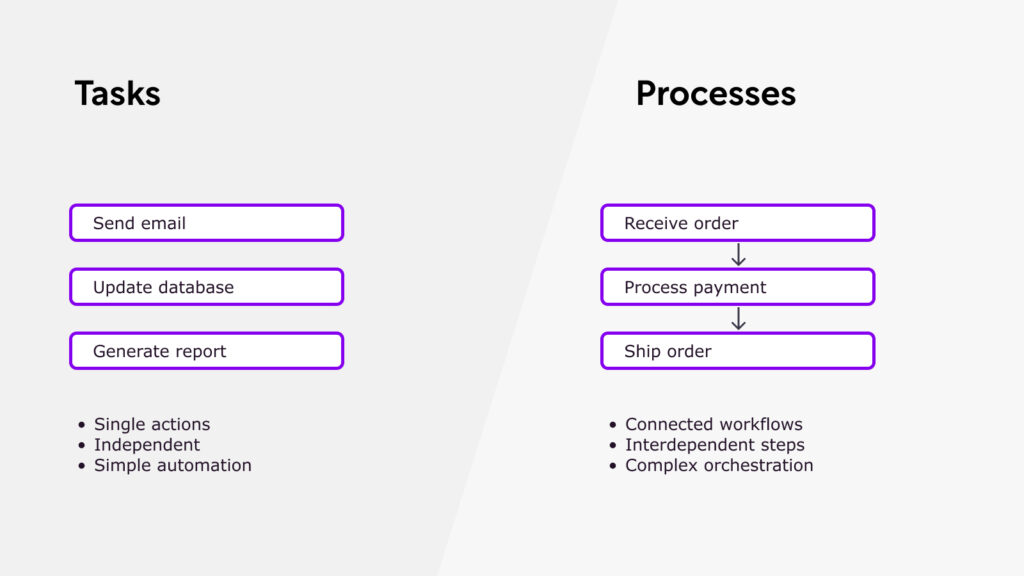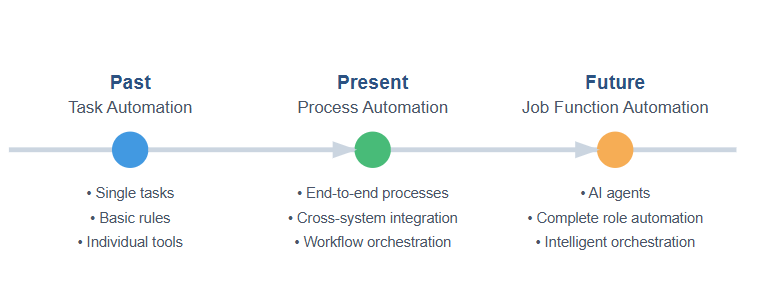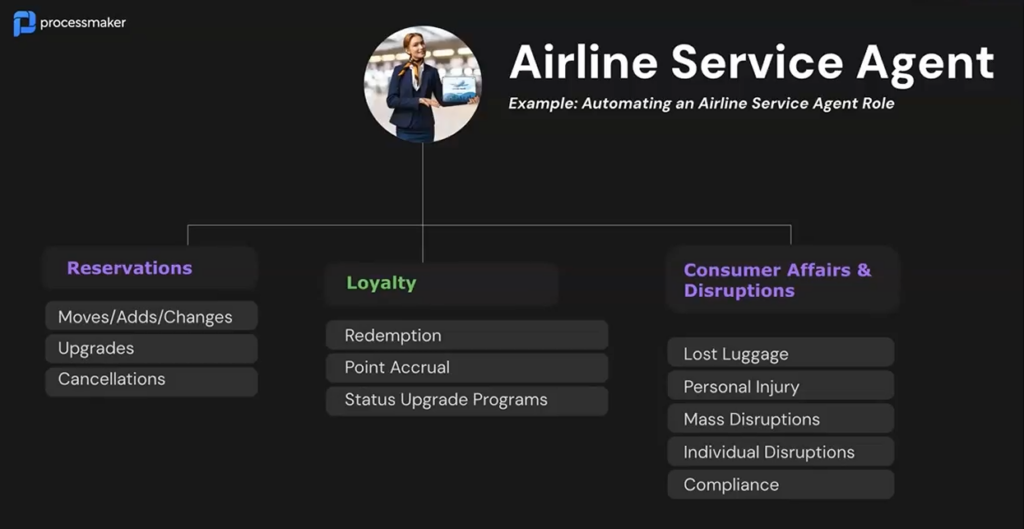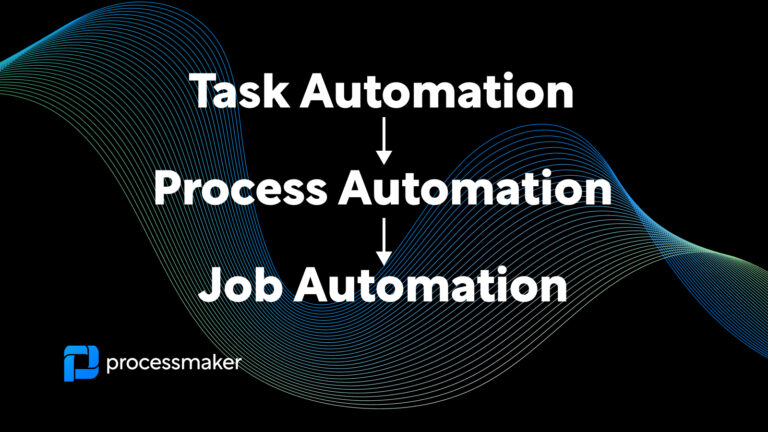The job market has been permanently transformed by advancements in AI. According to the McKinsey Global Institute, as much as 50% of today’s work activities could be automated by 2035. This projection is not unrealistic, especially considering that automation itself is far from new.
For years, we’ve been leveraging automation across various aspects of work and life. It’s become so embedded in our routines that we often don’t even notice or fully appreciate its impact anymore. Think about it—bulk email scheduling, automatic bill payments, meeting reminders, transcription of audio and video content, order tracking and delivery updates, code suggestions, duplicate detection, auto-translation of documents—the list goes on.
Recently, automation has progressed beyond individual tasks. We’re now automating entire processes made up of multiple tasks. And today, the conversation has shifted to automating entire workflows, potentially encompassing entire job functions.
But how did we arrive at this stage? What factors have brought us to the point where automation is redefining the nature of work itself? To answer these questions, we’ll explore the evolution of business automation and the milestones that have shaped its development.
What is task automation?
Task automation represents the simplest form of business process automation (BPA). Its primary focus is on simplifying and speeding up repetitive, rule-based tasks. These are routine activities that can be clearly defined and efficiently carried out by software or machines. The goal of task automation is to reduce human involvement in straightforward processes, minimizing errors while allowing employees to dedicate their time to more complex and valuable work.
A common example of task automation is the automatic emails triggered when a prospect interacts with a website. For instance, you’ve likely experienced receiving an email seconds after submitting your contact information online. This kind of automation is straightforward to implement, as it deals with a single task within one department. Numerous software solutions are available to assist in setting up such automation, making it an accessible and effective starting point for organizations.
Examples of task automation:
- Data entry
- Sales pipeline update notifications
- Follow-up sequences based on prospect actions
- Digital signature collection and verification
- Invoice matching with purchase orders and receipts
- Expense categorization from receipt images
- Currency conversion in international transactions
- Response suggestions for common queries
- Employee timesheet processing and approval
- Benefits enrollment data processing
Benefits of task automation
- Increased accuracy: Automation reduces the likelihood of human errors, resulting in more precise and consistent outcomes.
- Time-saving for repetitive tasks: Automating repetitive tasks allows employees to focus on more strategic and creative aspects of their work.
- Reduction in human error: With predefined rules and instructions, task automation minimizes the risk of human mistakes.
Limitations of task automation
- Restricted to predefined tasks and operations: Task automation is limited to tasks that can be clearly defined and scripted. It cannot handle complex, unstructured processes.
- Limited scope in terms of adaptability: It is challenging to adapt task automation to evolving business needs, as it lacks the ability to learn and evolve.
- Minimal ROI for businesses in the long run: While task automation can save time and reduce errors, it doesn’t offer significant transformative change for businesses.

Tasks vs processes
What is process automation?
Process automation focuses on streamlining an entire end-to-end process, which consists of a series of interdependent tasks working together to achieve a broader business goal. Unlike task automation, process automation often involves multiple stakeholders and systems, requiring advanced integration and orchestration to ensure everything runs smoothly.
This approach manages the coordination of tasks within a process, handling their timing, dependencies, and data flow, while also ensuring proper handoffs between different stages and participants.
For instance, automatically generating an invoice is an example of task automation.
However, automating the entire order-to-cash process involves much more—it includes receiving the order, checking inventory, processing payments, coordinating shipping, communicating with the customer, and updating accounting records. Each of these steps is interconnected, working together as part of a seamless workflow.
While task automation simplifies individual, standalone activities (like saving a document automatically or sending an email alert), process automation takes this a step further by orchestrating related tasks into a cohesive, comprehensive workflow. This often extends across various departments and systems, creating efficiency on a larger scale and improving overall business operations.

Why is there a need for process automation?
Work tasks are deeply interconnected, often spanning multiple apps, systems, and teams. Automating individual tasks might provide short-term relief, but real efficiency comes from streamlining and mapping entire processes in the most effective way.
In your daily work, you might need to shift between multiple processes. Orchestration across software is essential to manage these smoothly. This orchestration should function seamlessly within a single platform while integrating with other tools such as ERP systems, CRM platforms, or specialized finance software.
Orchestration ensures the right steps happen at the right times. It determines which process to execute first, what follows, which tools need to be included, which forms should be sent, and where data should be retrieved from. Everything is interconnected and managed cohesively.
Below are examples of end-to-end process automation that companies have already implemented successfully. They often do this using specialized software or comprehensive BPA tools like ProcessMaker to achieve that level of optimization and functionality.
Examples of process automation:
- Lead Qualification Process
- SaaS Platform Onboarding
- Invoice Processing
- Expense Reimbursement
Benefits of process automation:
- End-to-end workflow automation
Process automation coordinates multiple tasks across different departments and systems into a seamless workflow. This creates a more efficient operation where each step triggers the next automatically, eliminating delays and reducing the need for manual handoffs.
- Cross-system integration
Process automation can integrate multiple software systems (ERP, CRM, specialized tools) into a unified workflow.
- Smooth coordination of process steps
The automation system knows the optimal sequence of tasks, required data sources, and the timing of each step in the process. This orchestration capability ensures that complex processes run smoothly without requiring human intervention to coordinate between stages.
- Scalability
Once a process is automated, it can handle increased volume without proportionally increasing overhead or risk of errors. This scalability allows businesses to grow operations without necessarily adding more staff for process management.
Could we automate entire job functions?
The next big question is whether we could automate entire job functions.
While automating simple processes is nothing new, it’s fairly straightforward when a process has clear boundaries and a defined flow. However, most work isn’t linear, and processes often consist of multiple interconnected elements. This is why automating workflows—rather than just isolated processes—has become so crucial. Workflows capture the complexity and overlapping nature of real work.
Now, when several workflows come together, they essentially form a job function. With the rise of Agentic AI, automating tasks and processes has become easier and more accessible than ever. These AI agents are poised to excel in specialized roles, and the key will be in orchestrating them effectively. By doing so, it’s possible to automate an entire job function, fundamentally transforming how work is done.
The role of Agentic AI
This is an example of Agentic AI automating an Airline Service Agent role.

Although this isn’t happening right away, it’s far from unrealistic. The necessary components are already in place; what’s needed is time and the ability to bring these elements together.
By orchestrating software applications, AI agents, RPA tools, and connectors, it will become possible to automate entire job functions. However, this will require a seamless integration of all these independent components to work as one unified system.
Will AI take over people’s jobs?
Enhanced automation doesn’t mean that all jobs will be taken over by machines, leaving no place for humans in the workforce. Instead, automation can relieve people from repetitive and tedious tasks, like continuously approving invoices, allowing them to focus their time and creativity on more strategic and fulfilling work.
While it’s true that some roles will inevitably be replaced by automation and AI, this shift also brings opportunities. People will need to adapt by upskilling or reskilling to remain competitive in the job market—but that’s a discussion for another time. Overall, advanced automation has the potential to drive more positive changes than negative ones, offering humans the chance to work smarter, not harder:
The time to act is now
The rapid growth of AI and automation technology marks a turning point in business evolution. We’ve moved from task automation to complete job function automation, and the time to act is now.
Delaying adoption risks falling behind competitors already leveraging these advancements. By orchestrating existing tools and AI systems today, your organization can lead this transformation and secure a lasting competitive edge.





